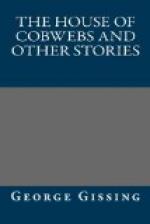’All the faults of the Italian people are whelmed in forgiveness as soon as their music sounds under the Italian sky. One remembers all they have suffered, all they have achieved in spite of wrong. Brute races have flung themselves, one after another, upon this sweet and glorious land; conquest and slavery, from age to age, have been the people’s lot. Tread where one will, the soil has been drenched with blood. An immemorial woe sounds even through the lilting notes of Italian gaiety. It is a country, wearied and regretful, looking ever backward to the things of old.’—(p. 130.)
The Ionian Sea did not make its appearance until 1901, but while he was actually in Italy, at Siena, he wrote the greater part of one of his very finest performances; the study of Charles Dickens, of which he corrected the proofs ‘at a little town in Calabria.’ It is an insufficient tribute to Gissing to say that his study of Dickens is by far the best extant. I have even heard it maintained that it is better in its way than any single volume in the ‘Man of Letters’; and Mr. Chesterton, who speaks from ample knowledge on this point, speaks of the best of all Dickens’s critics, ’a man of genius, Mr. George Gissing.’ While fully and frankly recognising the master’s defects in view of the artistic conscience of a later generation, the writer recognises to the full those transcendent qualities which place him next to Sir Walter Scott as the second greatest figure in a century of great fiction. In defiance of the terrible, and to some critics damning, fact that Dickens entirely changed the plan of Martin Chuzzlewit in deference to the popular criticism expressed by the sudden fall in the circulation of that serial, he shows in what a fundamental sense the author was ‘a literary artist if ever there was one,’ and he triumphantly refutes the rash daub of unapplied criticism represented by the parrot cry of ‘caricature’ as levelled against Dickens’s humorous portraits. Among the many notable features of this veritable chef-d’oeuvre of under 250 pages is the sense it conveys of the superb gusto of Dickens’s actual living and breathing and being, the vindication achieved of two ordinarily rather maligned novels, The Old Curiosity Shop and Little Dorrit, and the insight shown into Dickens’s portraiture of women, more particularly those of the shrill-voiced and nagging or whining variety, the ‘better halves’ of Weller, Varden, Snagsby and Joe Gargery, not to speak of the Miggs, the Gummidge, and the M’Stinger. Like Mr. Swinburne and other true men, he regards Mrs. Gamp as representing the quintessence of literary art wielded by genius. Try (he urges with a fine curiosity) ’to imagine Sarah Gamp as a young girl’! But it is unfair to separate a phrase from a context in which every syllable is precious, reasonable, thrice distilled and sweet to the palate as Hybla honey.[22]




